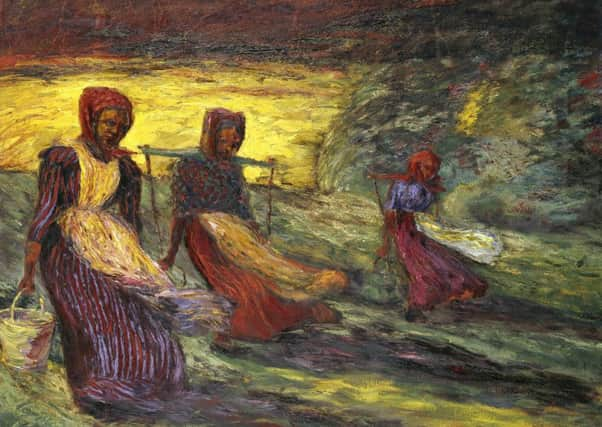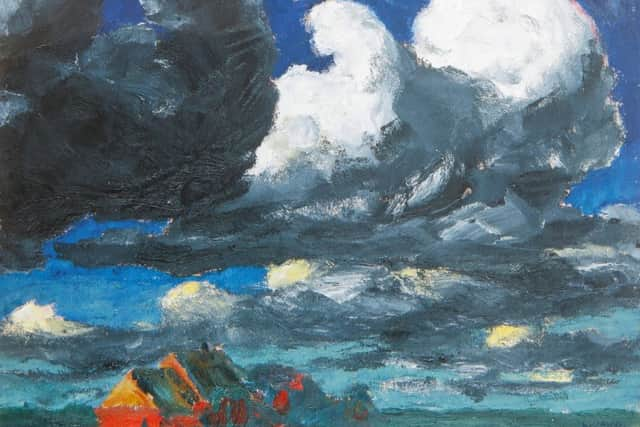Art review: Emil Nolde: Colour is Life, Scottish National Gallery of Modern Art, Edinburgh


Emil Nolde: Colour is Life, Scottish National Gallery of Modern Art, Edinburgh ****
Born Emile Hansen, when he married he took the name of his birthplace, Nolde. Nolde had been Danish, but just before his birth and after the disastrous (for Denmark) war of 1864 it had become German. Then half a century later, it became Danish again and Nolde became a Danish citizen. Nevertheless he thought of his art as distinctively German and in 1933 when Hitler came to power, he joined the National Socialists. He hoped the Nazis would recognise their vision of Germany in his art. Although this is generally given as some excuse for his joining the Nazis, it was not the only reason. He was also anti-Semitic, both in his paintings and in his autobiography.
Advertisement
Hide AdAdvertisement
Hide AdIn the second volume published in 1934, he portrayed himself as “a lone opponent of Jewish dominance in the art world of Germany.” He also remained a Nazi till 1945 even though they kicked him severely in the teeth. If Goebbels and Himmler had sympathy with his kind of art, Hitler, the artist, definitely did not and in 1937 Nolde was included in the notorious Degenerate Art Exhibition. Indeed he had more works than any other artist in the show. He also suffered from the confiscation of more than a thousand of his works and was subsequently forbidden to paint. At the end of the war, this rejection by the Nazis was accepted as evidence of his de-Nazification, although it is notable it was they who rejected him, not the other way around.


So what are we to make of him? Especially in this censorious age when past sins are so often seen as invalidating present achievements, should this troubled history have any bearing on his art? It is a tricky question and the National Gallery has clearly come down on the side of “No it shouldn’t.” In this they are also following the lead of the Gallery of Modern Art’s first director, Douglas Hall, who bought two works by Nolde for the collection in its early days.
Putting these reflections aside for the moment, however, you could best locate Nolde as an artist through his friendships and his artistic links. He was for instance a friend of Paul Klee and also of Karl Schmidt-Rottluff and at the latter’s invitation was in 1906 briefly a member of Die Brücke, the group associated with the beginnings of German Expressionism. Already in 1903, however, the pervasive rhythms and broken brushwork of Milkmaids I shows that he was profoundly influenced by Van Gogh. There is affinity with Van Gogh, too, in the way he uses quasi-religious subject matter to add poetic weight to his work and to claim a special, quasi-religious mission as an artist. (Van Gogh for instance painted himself as a Buddhist monk.) An early painting by Nolde, Free Spirit, exemplifies this. The “free spirit”, indeed it seems to be the artist, appears to be mocked, or at least questioned by three other figures, but his brilliant, red-gold robe quite outshines them. Reinforcing the religious analogy, this picture has echoes of early Italian painting in its simple, flat composition and also in colour, for Nolde uses saturated colour to convey shadow, thus increasing colour intensity just as Fra Angelico might have done. He had recently travelled to Italy, but denied it had any influence on him. Clearly he was not being honest either with himself or with us.
The portrayal of rural life in paintings like Frisians, Man and Woman, two brutal, frontal portraits on a single canvas, is in keeping with his belief in the artist’s privileged vision and also in the authenticity it derives from being rooted in the land, the Heimat. Van Gogh is still a model here too, however, as he is in the vivid Portrait of Dr H, a man with a massive, red, spade-shaped beard and vivid blue eyes. In the same year as these paintings, however, 1910, Nolde spent a month in Hamburg where he produced some very different works. Particularly striking is a set of dark and powerful etchings of the port. Originally trained as a wood carver, Nolde also took to woodcut with enthusiasm. Its natural quality appealed to him, but the rough, vivid images he produced also clearly recall Gauguin.
Nolde’s Danish wife Ada was a dancer and actress. The couple spent the winters in Berlin and Nolde took with enthusiasm to her world of theatre and cabaret. Some of the most compelling works here are rapid drawings of performers which are also scaled up into paintings like the frenetic Candle Dancers, two half-naked girls dancing among lighted candles.
In 1913, Nolde and his wife travelled via the trans-Siberian railway, China, Korea and Japan to Papua New Guinea. Gauguin’s example was clearly the inspiration for this remarkable journey to visit a “primtive” society. It is also apparent in the work Nolde produced there, though if this show is meant to present his career to an audience unfamiliar with it, it is an anecdote that takes up more space than it deserves.
The disruption of the First World War and its aftermath in Germany are reflected in violent paintings like Revolution, a crowded composition of angry heads, or the startling triptych Martyrdom. The side panels show men and women being eaten by lions in one and burnt at the stake in the other. The central panel shows the Crucifixion, but the figure of Christ is dwarfed by four hideous Jewish caricatures worthy of any crude propagandist of the Third Reich, although this was painted in 1921, 12 years before Hitler came to power. Here I think the question, bad man, bad art? surely gets an affirmative answer, but then you go on to Nolde’s later work and you see something different. Banned from painting by the Nazis, and unable to get materials, he produced a series of “Unpainted Pictures”, a title to pretend he wasn’t really painting and so deceive the Nazi inspectors, perhaps. These are small, strange watercolours with Strewel Peter-like figures in odd and sometimes quite haunting relationships.
Advertisement
Hide AdAdvertisement
Hide AdThe high point of the show comes at the end, however, in a painting of poppies entitled Red, Red, Red, and three wonderful, landscapes, two of the wild northern sea and one, the best painting in the show, of dramatic clouds above red cottages in the wide landscape of Nolde’s home. Robin Philipson paid homage to the poppies in some of his finest works. John Houston and John Bellany paid similar homage to the landscapes. They recognised them as definitively “northern” and so felt an affinity with Nolde and they were right.
In the end, good man or bad man – it doesn’t really matter looking at paintings like these.
Until 21 October